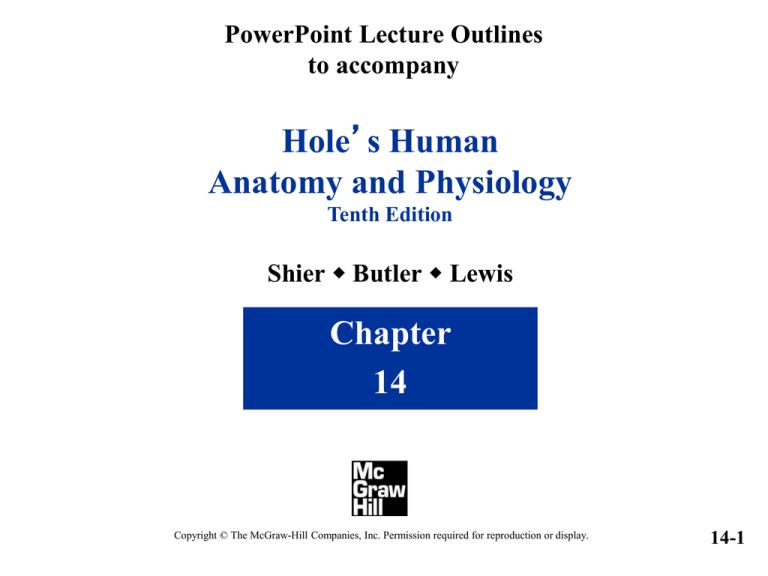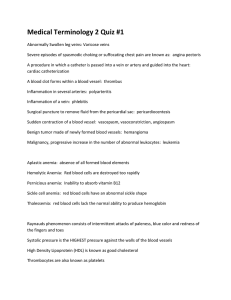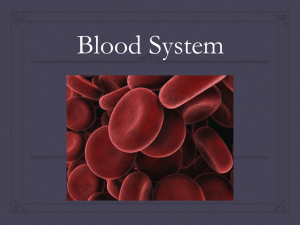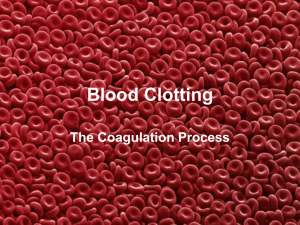Hole Anatomy and Physiology Chapter 14
advertisement

PowerPoint Lecture Outlines to accompany Hole’s Human Anatomy and Physiology Tenth Edition Shier w Butler w Lewis Chapter 14 Copyright © The McGraw-Hill Companies, Inc. Permission required for reproduction or display. 14-1 Chapter 14 Blood Functions • transports vital substances • maintains stability of interstitial fluid • distributes heat Blood Cells • form mostly in red bone marrow • red blood cells • white blood cells • platelets (cell fragments) 14-2 Blood Volume •about 8% of body weight • about 5 liters •varies with • body size • changes in fluid concentration • changes in electrolyte concentration • amount of adipose tissue 14-3 Blood Composition 14-4 Origin of Blood Cells 14-5 Red Blood Cells • erythrocytes • biconcave • one-third hemoglobin • oxyhemoglobin • deoxyhemoglobin • can readily squeeze through capillaries • lack nuclei and mitochondria 14-6 Red Blood Cell Count • number of RBCs in a cubic millimeter of blood • 4,600,000 – 6,200,000 in males • 4,200,000 – 5,400,000 in adult females • 4,500,000 – 5,100,000 in children • reflects blood’s oxygen carrying capacity 14-7 Red Blood Cell Production • low blood oxygen causes kidneys and liver to release erythropoietin which stimulates RBC production • vitamin B12, folic acid and iron necessary 14-8 Life Cycle of Red Blood Cell • circulate for about 120 days • macrophages in spleen and liver destroy worn out RBCs • hemoglobin is broken down into heme and globin • iron return to red bone marrow • bilirubin and biliverdin excreted in bile 14-9 Types of Anemia • aplastic anemia • bone marrow damaged • toxic chemicals • radiation • hemolytic anemia • RBCs destroyed • toxic chemicals • sickle cell anemia • abnormal shape of RBCs • defective gene • iron deficiency anemia • hemoglobin deficient • lack of iron • pernicious anemia • excess of immature RBCs • inability to absorb B12 • thalassemia • hemoglobin deficient • RBCs short-lived • defective gene 14-10 Hemolytic Anemia Normal RBCs RBCs of person with hemolytic anemia 14-11 White Blood Cells • leukocytes • protect against disease • interleukins and colony-stimulating factors stimulate development • granulocytes • neutrophils • eosinophils • basophils • agranulocytes • lymphocytes • monocytes 14-12 Neutrophils • light blue granules in acid-base stain • lobed nucleus • other names • segs • polymorphonuclear leukocyte • bands (young neutrophils) • first to arrive at infections • phagocytic • 54% - 62% of leukocyte • elevated in bacterial infections 14-13 Basophils • deep blue granules is basic stain • release histamine • release heparin • less than 1% of leukocytes 14-14 Eosinophils • deep red granules in acid stain • bilobed nucleus • moderate allergic reactions • defend against parasitic worm infestations • 1% - 3% of leukocytes • elevated in worm infestations and allergic reactions 14-15 Monocytes • largest blood cell • kidney-shaped or oval nuclei • leave bloodstream to become macrophages • 3% - 9% of leukocytes • elevated in typhoid fever, malaria, tuberculosis 14-16 Lymphocytes • about the size of RBC • large spherical nuclei • thin rims of cytoplasm • T cells • B cells • important in immunity • produce antibodies • 25% - 33% of leukocytes • decreased T Cells in AIDS 14-17 Diapadesis • leukocytes squeeze through capillary walls to enter tissue space outside the blood vessel 14-18 White Blood Cell Counts • number of WBCs per cubic millimeter of blood • 5,000 – 10,000 per cubic millimeter of blood • leukopenia • low WBC count • typhoid fever, flu, measles, mumps, chicken pox, AIDS • leukocytosis • high WBC count • acute infections, vigorous exercise, great loss of body fluids • differential WBC count • lists percentages of types of leukocytes • may change in particular diseases 14-19 Blood Platelets • thrombocytes • cell fragments of megakaryocytes • 130,000 – 360,000 per cubic millimeter of blood • helps control blood loss from broken vessels 14-20 Blood Plasma • straw colored • liquid portion of blood • 55% of blood 14-21 Plasma Proteins Albumins Alpha and Beta Globulins • most numerous plasma • originate in liver proteins • transport lipids and fat• originate in liver soluble vitamins • help maintain osmotic pressure of blood Fibrinogen • originate in liver • plays key role in blood coagulation Gamma Globulins • originate in lymphatic tissues • constitute the antibodies of immunity 14-22 Gases and Nutrients Gases • oxygen • carbon dioxide • nitrogen Nutrients • amino acids • simple sugars • nucleotides • lipids • lipoproteins 14-23 Plasma Lipoproteins Chylomicrons • high concentration of triglycerides • transport dietary fats to muscles and adipose cells LDLs • relatively high concentration of cholesterol • formed from VLDLs • deliver cholesterol to various cells VLDLs • relatively high concentration of triglycerides • produced in the liver • transport triglycerides from liver to adipose cells HDLs • relatively high concentration of proteins • relatively low concentration of lipids • transport remnants of chylomicrons to liver 14-24 Nonprotein Nitrogenous Substances • molecules containing nitrogen but are not proteins • urea – product of protein catabolism; about 50% of NPN substances • uric acid – product of nucleic acid catabolism • amino acids – product of protein catabolism • creatine – stores phosphates • creatinine – product of creatine metabolism • BUN – blood urea nitrogen; indicate health of kidney 14-25 Plasma Electrolytes • sodium • potassium • calcium • magnesium • chloride • bicarbonate • phosphate • sulfate • sodium and potassium most abundant 14-26 Hemostasis • stoppage of bleeding Blood Vessel Spasm • triggered by pain receptors, platelet release, or serotonin • smooth muscle in vessel contracts Platelet Plug Blood Coagulation Formation • triggered by • triggered by cellular damage exposure of and blood platelets to contact with collagen foreign surfaces • platelets • blood clot adhere to forms rough surface to form a plug 14-27 Platelet Plug Formation 14-28 Blood Coagulation 14-29 Blood Coagulation Extrinsic Clotting Mechanism • chemical outside of blood triggers blood coagulation • triggered by thromboplastin (not found in blood) • triggered when blood contacts damaged tissue Intrinsic Clotting Mechanism • chemical inside blood triggers blood coagulation • triggered by Hageman factor (found inside blood) • triggered when blood contacts a foreign surface 14-30 Blood Clots • After forming, blood clot retracts and pulls the edges of a broken vessel together • Platelet-derived growth factor stimulates smooth muscle cells and fibroblasts to repair damaged blood vessels • Plasmin digests blood clots • thrombus – abnormal blood clot • embolus – blood clot moving through blood 14-31 Prevention of Coagulation • The smooth lining of blood vessels discourages the accumulation of platelets • As a clot forms, fibrin absorbs thrombin and prevents the reaction from spreading • Antithrombin interferes with the action of excess thrombin • Some cells secrete heparin 14-32 ABO Blood Group 14-33 Agglutination 14-34 Preferred and Permissible Blood Types for Transfusion 14-35 Clinical Application Leukemia Myeloid Leukemia Lymphoid Leukemia • bone marrow produces • lymphocytes are cancerous too many immature • symptoms similar to granulocytes myeloid leukemia • leukemic cells crowd out other blood cells Treatments • anemia • blood transfusions • bleeding • marrow transplants • susceptible to • anti-cancer drugs infections • stem cell transplants 14-36







